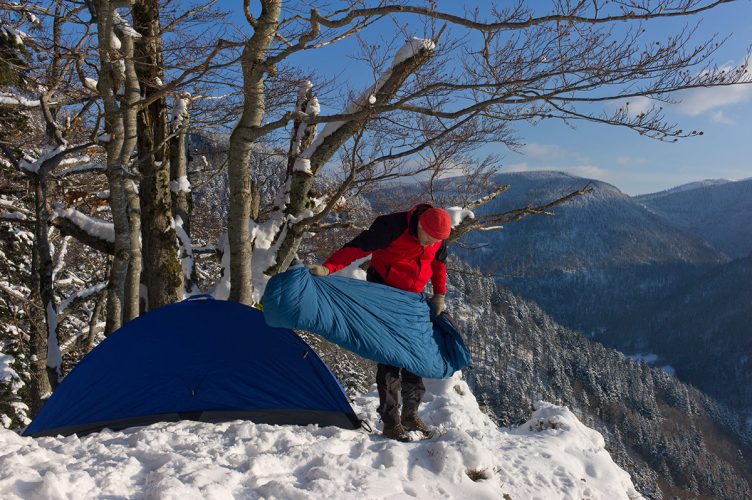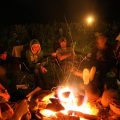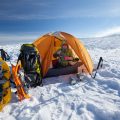Last Updated on August 5, 2023 by Dean Anderson
A winter camping trip in colder temperatures brings challenges. One of the biggest problems? Staying warm!
It’s easy to stay warm when you are hiking and moving around. But, at the end of the day, proper sleep is a must.
A night of good sleep means resting comfortably throughout the night. There is nothing worse than waking up cold.
Sleep is needed so that you can rest and prepare for upcoming adventures. Don’t be the grumpy one around camp.
Reliable ways to keep you warm while camping
The good news is that there are plenty of reliable ways to keep warm when facing the great (cold) outdoors! Having the right camping gear is important but understanding how your body works helps too.
Here are 11 ways to stay warm during your cold-weather camping trips.
1. Pick a Good Camp Site
During the off-season, there are endless places to set up camp. Instead of picking the first campsite, you come across, find one that works in your favor.
When picking a campsite, avoid low areas. Valleys and other low areas are typically colder. These areas are also more likely to experience wind.
Your campsite should:
- Be no less than 50 feet above the valley floor
- Have tightly packed snow
- Face downhill to avoid cold airflow
- Be suitable to build a fire
With the right campsite, you’ll have a better chance of staying warm.
2. Eat Plenty of Calories

Did you know that the average winter backpacker needs 4,500-5,000 calories a day? Camping isn’t the time to worry about the number on the scale!
Foods high in fat and protein are the order of the day. These foods keep you feeling fuller for longer and burn calories slower, keeping you warmer for longer. Simple food dishes like pancakes or scrambled eggs are also easy to make and can be combined with all manner of accompaniments to create a substantial meal.
You’ll also want to pack plenty of snacks.
Snacks are a great way to replenish burned calories while on-the-go.
Quality winter camping snacks include:
- Instant soup
- Peanut butter
- Granola bars
- Oatmeal
- Trail mix
- Meat sandwiches (tuna, lunch meat, etc.)
Calories are units of heat. When calories are burned, your body is kept warm and energized. Calories are especially important if you are shivering!
While calories are important, don’t forget about proper hydration. Ensure you are drinking at least a gallon of water a day.
The right food and drink will keep you warm.
3. Have the proper clothing
Your best plan of attack is to dress in layers. This will allow you to regulate body temperature according to weather conditions by adding and subtracting clothes as conditions dictate.
While preventing heat loss is important you also need to avoid sweating. Sweat will soak into clothing and once you cool down you’ll feel the chill.
Clothing to pack might include:
- Long underwear
- Dry socks, several pairs
- Gloves
- Hat
- Water-resistant boots
- Insulating but breathable base-layers
- Warm but not so bulky mid-layers
- Wind and waterproof outer-layers, puffies, and shells
One of the keys to staying warm is having a warm head. When exposed, most of your body heat escapes through your head. A good quality hat or even a balaclava will help here.
At the end of the day, especially if you’ve been out on a hike having clothes to change into is a bonus. Removing potentially sweaty layers and changing into dry clothes can be really uplifting and something to look forward to. Merino wool products are great at wicking moisture and feel luxurious to the skin.
Thermals are perfect for bedtime and will help you get a good night’s rest.
4. Bring the Right Sleeping Bag

When temperatures are low, an extra-warm sleeping bag is a must. Consider purchasing a 0-degree bag. You might also want to consider a fleece-lined sleeping bag liner. They’re relatively light and add an insulating layer.
Are you a female camper? If so, purchase a woman’s sleeping bag. Women will appreciate a mummy bag that will hug your body shape helping you to stay warm camping all night!
A woman’s sleeping bag offers extra insulation at the bottom and top. These bags are also fitted.
This means fewer air pockets and more trapped heat!
Your choice of sleeping bag should also be temperature rated, ideally to zero degrees or better. It needs to be an option rated for four-season use.
Another tip is to keep your head out of the sleeping bag while sleeping. The warm air you breathe into your bag can actually condense and cool. All your hard work to stay warm will be undone.
Aside from a sleeping bag, you may also want to pack extra thick blankets. These obviously add bulk which is fine if you’re car camping but not so convenient if you’re backpacking.
Want to keep your body off of the ground? Consider bringing an inflatable sleeping pad, air mattress, or camping cot.
5. Double up on sleeping pads
This is a relatively lightweight hack to insulating yourself from the cold ground. A sleeping pad has an R-Value which is essentially its thermal resistance. By doubling up on what is a fancy closed-cell foam pad (CCF) you’re essentially getting twice the R-Value and insulating power.
Look out for a sleeping pad with reflective coatings or fabrics. These can capture radiant heat and increase warmth by 15-20%, especially the models from the likes of Thermarest that incorporate a dimpled design. They look a little like a space blanket.
6. Vent your tent
This might sound counterintuitive but you need to ensure air can flow in and out of your tent. That’s because trapped warm air from your body contains water vapor that can condense when it hits a surface. In really low temperatures this can form ice.
We’re not talking about opening every zipper or flap just opening a single vent slightly so that the tent can breathe.
7. Follow a Bed Time Routine
When camping, a bedtime routine is a must! To keep warm, you’ll want to do a few physical movements before hitting the sack. This will increase your core temperature.
During sleep, the body cools. This means that you’ll want to go to bed warm!
Consider a brisk walk. This will raise your temperature and heart rate. Remember exercise also releases those feel-good endorphins and makes you feel positive.
There are also many ways to raise your body’s temperature right in your tent. Proven methods include:
- Jumping jacks
- Squats
- Push-ups
- Drinking hot fluids
Your routine should also involve proper bedtime camping clothing. Don’t hesitate to sleep with your socks and a hat on.
The more insulating layers you wear to bed, the warmer you will be but remember you don’t want to sweat.
8. Bring Extra Heat Sources
Another effective method for keeping warm camping is to bring additional heat sources. There are plenty of items that can be used to provide heat.
These items include:
- The capability to light a fire
- Reusable heater packs
- Disposable hand warmers
- A good quality hot water bottle filled with hot water
- A sock with heated rocks inside
- A propane tent heater
When sleeping with a suitable heat source, place it between your legs, near your groin (not the fire or space heater of course!). This will flow the heat along your femoral artery, warming your whole body. This is a far more efficient method to keep warm than placing a water bottle near your feet, for example, which is the traditional wisdom.
If the heat source is too hot to the touch, use a towel to lessen the heat exposure.
9. Consider Close Quarter Sleeping

A smaller winter-style tent is more likely to keep you warm. Small tents have less space to heat and areas of heat escape. This means you’re more likely to stay warm during the night.
Another way of keeping warm in a tent is to cuddle or position sleeping bags and pads close together. Body-to-body warming is a really effective method of staying warm as you’re decreasing the body’s area of exposure to cold air.
You’ll want to go camping with someone you’re comfortable sleeping close to for this method to work. As an alternative take your pooch with you, dogs have a higher body temperature than humans do so body-to-body warming works even better in this instance.
10. Keep Your Gear Dry
Wet gear means a cold camper. Ensure your bedtime clothes are entirely dry.
The same goes for your tent and sleeping bag. Sleeping when it’s cold and damp can be near impossible.
Protect your gear and keep it dry by practicing proper storage. If your gear does get wet, do not sleep in it! Instead, let it dry and try wearing that piece of clothing another time.
11. Take a pee bottle to bed
This might sound a little gross but during the night you want minimal disruption. If you have to exit the tent for a call of nature then you’re going to lose heat and maybe expose other people to the cold.
If you do need to go then don’t wait. Your body uses tons of calories just to keep urine warm. Just get the job done.
A pee bottle, marked up as such, with a good tight-fitting cap can be a lifesaver. If the weather really is extreme you might even want to take that warmth back into your sleeping bag. A wide-mouth bottle or collapsible container might be an option for ladies, or check out many of the pee funnels on the market.
12. Don’t drink too much alcohol before sleeping
Sure one of the reasons you might go on a camping trip is to relax and enjoy a drink or two. Just understand that alcohol dehydrates you and unfortunately dehydration makes you colder, a double whammy. You don’t want to ruin the camping experience with a hangover either.
Lastly, if you’re drinking a lot before bedtime you’re going to need that pee bottle!

Eight years ago, I took a risk and left a miserable office job to follow a lifestyle career that involved my love for the great outdoors. I’ve taken my love for camping, hiking and travel to the next level by running my small campground with a friend near Portland, Oregon. It’s for way less money but this has truly been a dream come true and the running involves lots of family and friends.
The next evolution of that was to get online and start allcampingstuff.com. At our campground, I spend a lot of time setting up camping equipment for customers and disposing of the garbage products they leave behind. If I can help just a few people with advice on good camping gear, then this website venture will be worth it.
So, if you want to avoid the duds and spend your money wisely you’ve hopefully come to the right place.








